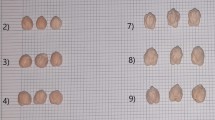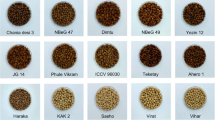Abstract
The seeds of chickpea provide an exceptional source of dietary proteins and is one of the important legumes in both developed and develo** countries over the world. The available germplasm of cultivated chickpea is deficient in desired biochemical signatures. To identify new sources of variations for breeding, reduced subsets of germplasm such as mini-core collection can be explored as an effective resource. In the present investigation, mini-core collections consisting of 215 accessions of chickpea were extensively evaluated for tap** biochemical diversity. Analysis included ten biochemical parameters comprising total protein, total free amino acids, phytic acid, tannin, total phenolics, total flavonoids, lectin, DPPH radical scavenging activity, in vitro digestibility of protein and starch. The spectrum of diversity was documented for total protein (4.60–33.90%), total free amino acids (0.092–9.33 mg/g), phytic acid (0.009–4.06 mg/g), tannin (0.232–189.63 mg/g), total phenolics (0.15–0.81 mg/g), total flavonoids (0.04–1.57 mg/g), lectin (0.07–330.32 HU/mg), DPPH radical scavenging activity (26.74–49.11%), in vitro protein digestibility (59.45–76.22%) and in vitro starch digestibility (45.63–298.39 mg of maltose/g). The principal component analysis revealed association of chickpea higher protein content to the lower level of total phenolics and flavonoid contents. The dendrogram obtained by unweighted pair group method using arithmetic average cluster analysis grouped the chickpea accessions into two major clusters. This is the first comprehensive report on biochemical diversity analysed in the mini-core chickpea accessions. The ultimate purpose of conducting such studies was to deliver information on nutritional characteristics for effective breeding programmes. Depending on the objectives of the breeding aforesaid accessions could be employed as a parent.




Similar content being viewed by others
References
Alajaji AS, El-Adawy AT (2006) Nutritional composition of chickpea (Cicer arietinum L.) as affected by microwave cooking and other traditional cooking methods. J Food Compos Anal 19:806–812. https://doi.org/10.1016/j.jfca.2006.03.015
Bersuder P, Hole M, Smith G (1998) Antioxidants from a heated histidine glucose model system I: investigation of the antioxidant role of histidine and isolation of antioxidants by high performance liquid chromatography. J Am Oil Chem Soc 75:181–187. https://doi.org/10.1007/s11746-998-0030-y
Bhagyawant SS, Gupta N, Shrivastava N (2015) Biochemical analysis of chickpea accessions vis-a-vis; zinc, iron, total protein, proline and antioxidant activity. Am J Food Sci Technol 3(6):158–162. https://doi.org/10.12691/ajfst-3-6-3
Cai Y, Luo Q, Sun M, Corke H (2004) Antioxidant activity and phenolic compounds of 112 traditional Chinese medicinal plants associated with anticancer. Life Sci 74:2157–2184. https://doi.org/10.1016/j.lfs.2003.09.047
Chitra U, Singh U, Rao PV (1996) Phytic acid, in vitro protein digestibility, dietary fiber, and minerals of pulses as influenced by processing methods. Plant Foods Hum Nutr 49:307–316. https://doi.org/10.1007/BF01091980
Doke S, Guha M (2015) Nutritional, physico-chemical and functional properties of ready-to-use chickpea and soybean flour. Int J Food Nutr Sci 4(5):2320–7876
Fan TY, Sosulski FW (1974) Dispersibility and isolation of protein from legume flours. Can Inst Food Sci Technol J 7:256–259. https://doi.org/10.1016/S0315-5463(74)73923-2
Francis G, Makkar HPS, Becker K (2001) Antinutritional factors present in plant-derived alternate fish feed ingredients and their effects in fish. Aquaculture 199:197–227. https://doi.org/10.1016/S0044-8486(01)00526-9
Frankel OH (1984) Genetic perspective of germplasm conservation. In: Arber W, Illmensee K, Peacock WJ, Starlinger P (eds) Genetic manipulation: impact on man and society. Cambridge University Press, Cambridge, pp 161–170
Gautam AK, Gupta N, Narvekar DT, Bhadkariya R, Bhagyawant SS (2018a) Characterization of chickpea (Cicer arietinum L.) lectin for biological activity. Physiol Mol Biol Plants 24(3):389–397. https://doi.org/10.1007/s12298-018-0508-5
Gautam AK, Srivastava N, Nagar DP, Bhagyawant SS (2018b) Biochemical and functional properties of a lectin purified from the seeds of Cicer arietinum L. 3 Biotech 8:272. https://doi.org/10.1007/s13205-018-1272-5
Gupta N, Shrivastava N, Bhagyawant SS (2017) Multivariate analysis based on nutritional value, antinutritional profile and antioxidant capacity of forty chickpea genotypes grown in India. J Nutr Food Sci 7(3):1000600. https://doi.org/10.4172/2155-9600.1000600
Hsu HW, Vavak DL, Satterlee LD, Miller GA (1977) A multienzyme technique for estimating protein digestibility. J Food Sci 42:1269–1273. https://doi.org/10.1111/j.1365-2621.1977.tb14476.x
Imura K, Okada A (1998) Amino acid metabolism in pediatric patients. Nutrition 14(1):143–148. https://doi.org/10.1016/S0899-9007(97)00230-X
Kahraman A, Pandey A, Khan MK (2017) Nutritional diversity assessment in chickpea—a prospect for nutrient deprived world. Harran J Agric Food Sci 21(3):357–363
Kashiwagi J, Krishnamurthy L, Upadhyaya HD, Krishna H, Chandra S, Vadez V, Serraj R (2005) Genetic variability of drought-avoidance root traits in the mini-core germplasm collection of chickpea (Cicer arietinum L.). Euphytica 146:213–222. https://doi.org/10.1007/s10681-005-9007-1
Kaur K, Kaur N, Gupta AK, Singh I (2013) Exploration of the antioxidative defense system to characterize chickpea genotypes showing differential response towards water deficit conditions. Plant Growth Regul 70:49–60. https://doi.org/10.1007/s10725-012-9777-0
Kaur N, Kumar A, Kaur K, Kaur S, Gupta AK, Singh I (2014) Abiotic stress tolerance of chickpea genotypes depends upon antioxidative potential and nutritional quality of seeds. Proc Natl Acad Sci India Sect B Biol Sci 85(2):615–623. https://doi.org/10.1007/s40011-014-0382-z
Khoo HE, Azlan A, Ismail A, Abas F (2013) Response surface methodology optimization for extraction of phenolics and antioxidant capacity in defatted dabai parts. Sains Malays 42(7):949–954
Kumar S, Kapoor V, Gill K, Singh K, Xess I, Das SN, Dey S (2014) Antifungal and antiproliferative protein from Cicer arietinum: a bioactive compound against emerging pathogens. Biomed Res Int. https://doi.org/10.1155/2014/387203
Liener IE (1962) Toxic factors in edible legumes and their elimination. Am J Clin Nutr 11:281–298
Lis H, Sharon N (1986) Lectin as molecules and as tools. Annu Rev Biochem 55:35–67. https://doi.org/10.1146/annurev.bi.55.070186.000343
Lowry OH, Rosebrough NJ, Farr AL, Randall RJ (1951) Protein measurement with the phenol reagent. J Biol Chem 193:265–275
Luo XD, Basile MJ, Kennelly EJ (2002) Polyphenolic antioxidants from the fruits of Chrysophyllum cainito L. (star apple). J Agric Food Chem 50:1379–1382. https://doi.org/10.1021/jf011178n
Martin LP, Rangel MB, Zamarreno MMD (2017) Classification of lentils, chickpeas and beans based on their isoflavone content. Food Anal Methods 10:1191–1201. https://doi.org/10.1007/s12161-016-0675-3
Mekbungwan A (2007) Application of tropical legumes for pig feed. Anim Sci J 78:343–350. https://doi.org/10.1111/j.1740-0929.2007.00446.x
Melki M, Gasouri A, Bouhadida M, Chograni H, Rezgui M (2017) Phenotypic, genetic and biochemical characterization of five Tunisian varieties of chickpea. J Agric Stud 5(1):77–89. https://doi.org/10.5296/jas.v5i1.10808
Moore S, Stein WH (1948) Analysis of amino acids. In: Colowick SP, Kaplan NO (eds) Methods in enzymology. Academic Press, New York, pp 468–471
Muhammad ZH, Shahid I, Shakeel A, Muhammad I, Abdul N, Bhanger MI (2007) Nutritional and compositional study of desi chickpea (Cicer arietinum L.) cultivars grown in Punjab, Pakistan. Food Chem 105:1357–1363. https://doi.org/10.1016/j.foodchem.2007.05.004
Pande S, Krishna Kishore G, Upadhyaya HD (2006) Identification of sources of multiple disease resistance in mini-core collection of chickpea. Plant Disease 90(9):1214–1218. https://doi.org/10.1094/PD-90-1214
Parameshwarappa SG, Salimath PM, Upadhyaya HD, Patil SS, Kajjidoni ST (2012) Genetic variability studies in minicore collection of chickpea (Cicer arietinum L.) under different environments. Karnataka J Agric Sci 25(3):305–308
Peng X, Zheng ZP, Cheng KW, Shan F, Ren GX, Chen F, Wang M (2008) Inhibitory effect of mung bean extract and its constituents vitexin and isovitexin on the formation of advance glycation endproducts. Food Chem 106:475–481. https://doi.org/10.1016/j.foodchem.2007.06.016
Quintero-Soto MF, Saracho-Peña AG, Chavez-Ontiveros J, Garzon-Tiznado JA, Pineda-Hidalgo KV, Delgado-Vargas F, Lopez-Valenzuela JA (2018) Phenolic profiles and their contribution to the antioxidant activity of selected chickpea genotypes from Mexico and ICRISAT collections. Plant Foods Hum Nutr. https://doi.org/10.1007/s11130-018-0661-6
Reddy NR, Sathe SK, Salunkhe DK (1982) Phytate in legumes and cereals. Adv Food Res 28:1–92. https://doi.org/10.1016/S0065-2628(08)60110-X
Roorkiwal M, Jain A, Thudi M, Varshney RK (2017) Advances in chickpea genomic resources for accelerating the crop improvement. In: Varshney R, Thudi M, Muehlbauer F (eds) The chickpea genome, compendium of plant genomes. Springer, Cham, pp 53–67. https://doi.org/10.1007/978-3-319-66117-9_6
Roy F, Boye JI, Simpson BK (2010) Bioactive proteins and peptides in pulse crops: pea, chickpea and lentil. Food Res Int 43:432–442. https://doi.org/10.1016/j.foodres.2009.09.002
Saeed A, Darvishzadeh R (2016) Genetic diversity in a minicore collection of Cicer accessions using amplified fragment length polymorphism (AFLP). Arch Agron Soil Sci 62(12):1711–1721. https://doi.org/10.1080/03650340.2016.1159302
Schandrel SH (1970) Method in food analysis. Academic Press, New York
Serraj R, Krishnamurthy L, Upadhyaya HD (2004) Screening chickpea minicore germplasm for tolerance to soil salinity. ICPN 11:29–32
Singh U, Jambunathan R (1981) Studies on desi and kabull chickpea (Cicer arietinum L.) cultivars: levels of protease inhibitors, levels of polyphenolic compounds and in vitro protein digestibility. J Food Sci 46:1364–1367. https://doi.org/10.1111/j.1365-2621.1981.tb04176.x
Singh U, Kherdekar MS, Jambunathan R (1982) Studies on desi and kabuli chickpea (Cicer arietinum L.) cultivars. The levels of amylase inhibitors, levels of oligosaccharides and in vitro starch digestibility. J Food Sci 47:510–512. https://doi.org/10.1111/j.1365-2621.1982.tb10113.x
Swain U, Hillis WE (1959) The phenolic constituents of Prunus domestica. I. The quantitative analysis of phenolic constituents. J Agric Food Chem 10:63–68. https://doi.org/10.1002/jsfa.2740100110
Tan GZH, Das Bhowmik SS, Hoang TML, Karbaschi MR, Johnson AAT, Williams B, Mundree SG (2017) Finger on the pulse: pum** iron into chickpea. Front Plant Sci 8:1755. https://doi.org/10.3389/fpls.2017.01755
Thudi K, Roorkiwal M, Kudapa H, Chaturvedi SK, Singh NP, Varshey RK (2017) An overview of chickpea research: from discovery to delivery. Pulse India 2(5):22–25
Upadhyaya HD, Ortiz R (2001) A mini core subset for capturing diversity and promoting utilization of chickpea genetic resources in crop improvement. Theor Appl Genet 102:1292–1298. https://doi.org/10.1007/s00122-001-0556-y
Upadhyaya HD, Yadav D, Dronavalli N, Gowda CLL, Singh S (2010) Mini core germplasm collections for infusing genetic diversity in plant breeding program. Electr J Plant Breed 1(4):1294–1309
Upadhyaya HD, Dronavalli N, Dwivedi SL, Kashiwagi J, Krishnamurthy L, Pande S, Sharma HC, Vadez V, Singh S, Varshney RK, Gowda CLL (2013) Mini core collection as a resource to identify new sources of variation. Crop Sci 53(6):2506–2517
Vadivel V, Janardhanan K (2005) Nutritional and antinutritional characteristics of seven Indian wild legumes. Plant Foods Hum Nutr 60:69–75. https://doi.org/10.1007/s11130-005-5102-y
Varshney RK, Ribaut JM, Buckler ES, Tuberosa R, Rafalski JA et al (2012) Can genomics boost productivity of orphan crops? Nat Biotechnol 30:1172–1176. https://doi.org/10.1007/978-3-319-66117-9_6
Vidal-Valverde C, Frias J, Estrella I, Gorospe MJ, Ruiz R, Bacon J (1994) Effect of processing on some antinutritional factors of lentils. J Agric Food Chem 42:2291–2295. https://doi.org/10.1021/jf00046a039
Wilcox JK, Premchandra GS, Young KA, Raboy V (2000) Isolation of high seed inorganic P, low-phytate soybean mutants. Crop Sci 40:1601–1605. https://doi.org/10.2135/cropsci2000.4061601x
Xu Y, Cartier A, Obielodan M, Jordan K, Hairston T, Shannon A, Sismour E (2016) Nutritional and anti-nutritional composition, and in vitro protein digestibility of kabuli chickpea (Cicer arietinum L.) as affected by differential processing methods. J Food Meas Charact 10(3):625–633. https://doi.org/10.1007/s11694-016-9346-8
Yao Y, Sang W, Zhou MJ, Ren GX (2010) Phenolic composition and antioxidant activities of 11 celery cultivars. J Food Sci 75:C9–C13. https://doi.org/10.1111/j.1750-3841.2009.01392.x
Zhang J, Shi J, Illic S, Jun XS, Kakuda Y (2009) Biological properties and characterization of lectin from red kidney bean (Phaseolus vulgaris). Food Rev Int 25:12–27. https://doi.org/10.1080/87559120802458115
Zhang D, Chu L, Liu YX et al (2011) Analysis of the antioxidant capacities of flavonoids under different spectrophotometric assays using cyclic voltammetry and density functional theory. J Agric Food Chem 59(18):10277–10285. https://doi.org/10.1021/jf201773q
Acknowledgements
Ajay Kumar Gautam is grateful to University of Grants Commission (UGC), New Delhi for providing research fellowship under major research project (F.No. 40-154/2011 (SR). Authors are also grateful to ICRISAT, Hyderabad, (A.P.) India for providing the seed samples. Dr. Sushma Tiwari, Scientist, Rajmata Vijayaraje Scindia Krishi Vishwa Vidyalaya, Gwalior is thankfully acknowledged for providing statistical software support.
Author information
Authors and Affiliations
Corresponding author
Ethics declarations
Conflict of interest
No conflict of interest was reported by the authors.
Electronic supplementary material
Below is the link to the electronic supplementary material.
Rights and permissions
About this article
Cite this article
Bhagyawant, S.S., Gautam, A.K., Narvekar, D.T. et al. Biochemical diversity evaluation in chickpea accessions employing mini-core collection. Physiol Mol Biol Plants 24, 1165–1183 (2018). https://doi.org/10.1007/s12298-018-0579-3
Received:
Revised:
Accepted:
Published:
Issue Date:
DOI: https://doi.org/10.1007/s12298-018-0579-3




